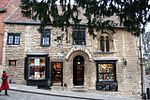St Martin's Church, Lincoln
Church of England church buildings in LincolnshireChurches in Lincoln, England

St Martin's Church was among the oldest churches in the city of Lincoln, England. It has been suggested that during the Anglo-Saxon Period and during the Danelaw, St Martin was considered to be the patron saint of Lincoln. The church is likely to have been associated with the rare St Martin silver pennies minted in Lincoln, probably before 918 A.D, when Lincoln was taken back from the Danes by the Anglo-Saxons.
Excerpt from the Wikipedia article St Martin's Church, Lincoln (License: CC BY-SA 3.0, Authors, Images).St Martin's Church, Lincoln
St Michael's Terrace, Lincoln New Boultham
Geographical coordinates (GPS) Address Nearby Places Show on map
Geographical coordinates (GPS)
| Latitude | Longitude |
|---|---|
| N 53.232869444444 ° | E -0.54026388888889 ° |
Address
St Michael's Terrace
St Michael's Terrace
LN1 1HX Lincoln, New Boultham
England, United Kingdom
Open on Google Maps











